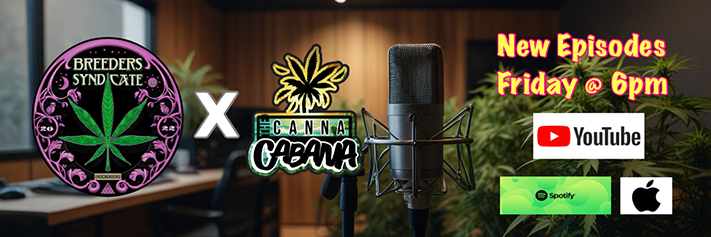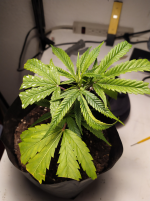Lithium
Lithium•Iron•Boron
Found this to be semi-interesting. Sorry if posted elsewhere.
Dark Heart Nursery Identifies New Pathogen, Creates Patent-Pending Process for Testing and Eliminating Cannabis “Dudding”
From link:
Nice to see they've identified the pathogen they've spread to hundreds/thousands of gardens. And patented the "cure".


Thoughts?
Dark Heart Nursery Identifies New Pathogen, Creates Patent-Pending Process for Testing and Eliminating Cannabis “Dudding”
From link:
OAKLAND, Calif.--(BUSINESS WIRE)--Dark Heart Nursery (DHN) proudly announces that it is the first organization to positively identify hop latent viroid (HpLVd) as the cause of “dudding” in cannabis. Since 2018, DHN has also been successfully testing for and eliminating HpLVd through a patent-pending clean plant process.
On the heels of this groundbreaking completed research, the company has also announced that project lead Dr. Jeremy Warren has officially joined DHN as Director of Plant Health.
“The positive identification of the HpLVd pathogen and our patent-pending clean plant process to test for and eliminate it represent a significant advance towards keeping cannabis crops healthy and supporting long-term business growth for cultivators,” said Dan Grace, Founder and President of Dark Heart Nursery. “With Dr. Warren at the helm, we are incredibly excited to now offer diagnostic and curative services for HpLVd to licensed cannabis businesses in California, as well as continue our research in identifying and eradicating additional cannabis-infecting pathogens.”
“Dudding” is a colloquial name for a variety of symptoms, which include loss of vigor, stunting, reduction in yield, reduction in potency and changes in morphology. The syndrome was codified in 2017 by Dr. Rick Crum who first coined the phrase “Putative Cannabis Infectious Agent” (PCIA) to describe it. In 2015, Dr. Crum reported that as many as 35 percent of observed plants showed PCIA symptoms.
In 2017, Dark Heart Nursery began working with Dr. Warren to determine the cause of PCIA. Symptomatic and asymptomatic plants were collected, and next generation RNA sequencing was performed to determine a probable cause of the disease. After analysis of the results in November 2017, it was determined that Hop latent viroid (HpLVd) was the most likely candidate pathogen. A genetic test was then developed to aid in differentiating healthy plants from infected plants.
“It is important to note that finding a potential pathogen within a plant was only the first step in determining if the pathogen is indeed causing the disease in question,” said Dr. Warren. “To demonstrate causality, healthy plants were inoculated with an infectious clone of HpLVd to confirm that the developed symptoms were consistent with PCIA. Our team monitored these infected plants, as well as controlled (healthy) plants for three months to track symptom development. After this time, it was apparent that the HpLVd-infected plants were showing symptoms consistent with PCIA, such as yellowing of leaves, malformed leaves and stunted growth. These results confirmed that HpLVd is causing PCIA symptoms in cannabis.”
In 2014, DHN established the cannabis industry’s first tissue culture laboratory. Among other areas of research, this lab has focused on the development of clean plant protocols through which cannabis can be cured of pathogens and cataloged for later use. Under the leadership of Research Manager Will Roberts, the company developed a patent-pending clean process, which is capable of reliably eliminating HpLVd from infected specimens. For the last year, Dr. Warren’s discovery and subsequent diagnostic tests have allowed DHN’s lab team to reliably and demonstrably eliminate HpLVd. To date, 31 varietals have been cured of the disease.
Hop latent viroid (HpLVd) was first characterized in Humulus lupulus (hop) plants (Putcha et al. 1988). The initial research suggested it was a minor pathogen in hops; however, recent research has shown that infection with HpLVd can have a significant impact on yields and secondary metabolite production (Adams et al. 1991, Barbara et al. 1990, Matoušek 1994). These yield and metabolite impacts seem to be even more pronounced in cannabis. If plants are showing symptoms of HpLVd infection, there are a few actions to consider. Always remove infected plants from the growing area to prevent spread. HpLVd, like many viroids, has been shown to be primarily mechanically transmitted, so strong nursery sanitation protocols are necessary when pruning and processing plants. The secondary means of HpLVd transmission are not yet fully understood. However, other viroids in the Cocadviroid genus have been shown to be pollen and seed transmissible. This suggests that HpLVd may also be transmitted in a similar manner, but further study is required. Insect transmission of viroids is also still being studied. Cannabis plants can be carriers for HpLVd without showing any outward symptoms of the disease. For this reason, it is important to test all the plants in a mother block for HpLVd infection and to purchase clean plant materials whenever possible. Although the company’s work did not include any hemp varietals, it is highly likely that HpLVd also impacts that crop.
Nice to see they've identified the pathogen they've spread to hundreds/thousands of gardens. And patented the "cure".



Thoughts?














 Thanks again for the counsel.
Thanks again for the counsel.


